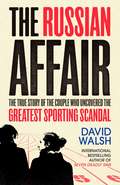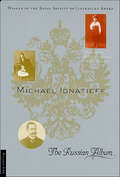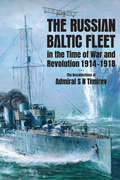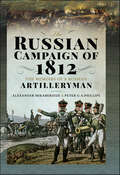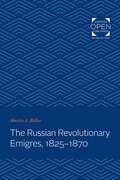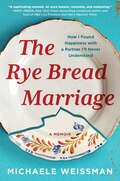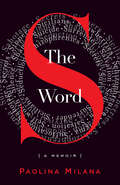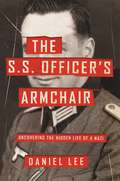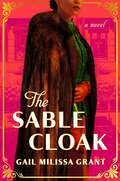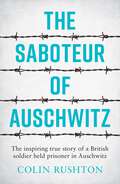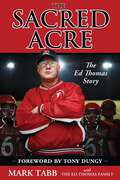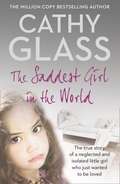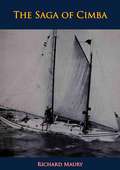- Table View
- List View
The Rural Diaries: Love, Livestock, and Big Life Lessons Down on Mischief Farm
by Hilarie BurtonThe beloved actress and star of One Tree Hill, White Collar, and Lethal Weapon, Hilarie Burton Morgan, tells the story of leaving Hollywood for a radically different kind of life in upstate New York with her husband Jeffrey Dean Morgan—a celebration of community, family, and the value of hard work in small town America. <P><P>While Hilarie Burton Morgan's hectic lifestyle as an actress in New York and Los Angeles gave her a comfortable life, it did not fulfill her spiritually or emotionally. After the birth of their first son, she and her husband Jeffrey Dean Morgan, the star of The Walking Dead, decided to make a major change: they bought a working farm in Rhinebeck, New York, and began a new chapter in their lives. <P><P>The Rural Diaries chronicles her inspiring story of farm life: chopping wood, making dandelion wine, building chicken coops. Burton looks back at her transition from urban to country living—discovering how to manage a farm while raising her son and making friends with her new neighbors. <P><P>She mixes charming stories of learning to raise alpacas and buying and revitalizing the town’s beloved candy store, Samuel’s Sweet Shop, with raw observations on the ups and downs of marriage and her struggles with secondary infertility. Burton also includes delicious recipes that can be made with fresh ingredients at home, as well as home renovation and gardening tips. <P><P>Burton’s charisma, wide eyed attitude, and fortitude—both internal and physical—propels this moving story of transformation and self-discovery. The Rural Diaries honors the values and lifestyle of small-town America and offers inspiration for anyone longing to embark on their own unconventional journey. <p><p><b>A New York Times Bestseller</b>
The Russia Hand: A Memoir of Presidential Diplomacy
by Strobe TalbottDuring the past ten years, few issues have mattered more to America's vital interests or to the shape of the twenty-first century than Russia's fate. To cheer the fall of a bankrupt totalitarian regime is one thing; to build on its ruins a stable democratic state is quite another. The challenge of helping to steer post-Soviet Russia-with its thousands of nuclear weapons and seething ethnic tensions-between the Scylla of a communist restoration and the Charybdis of anarchy fell to the former governor of a poor, landlocked Southern state who had won national election by focusing on domestic issues. No one could have predicted that by the end of Bill Clinton's second term he would meet with his Kremlin counterparts more often than had all of his predecessors from Harry Truman to George Bush combined, or that his presidency and his legacy would be so determined by his need to be his own Russia hand. With Bill Clinton at every step was Strobe Talbott, the deputy secretary of state whose expertise was the former Soviet Union. Talbott was Clinton's old friend, one of his most trusted advisers, a frequent envoy on the most sensitive of diplomatic missions and, as this book shows, a sharp-eyed observer. The Russia Handis without question among the most candid, intimate and illuminating foreign-policy memoirs ever written in the long history of such books. It offers unparalleled insight into the inner workings of policymaking and diplomacy alike. With the scope of nearly a decade, it reveals the hidden play of personalities and the closed-door meetings that shaped the most crucial events of our time, from NATO expansion, missile defense and the Balkan wars to coping with Russia's near-meltdown in the wake of the Asian financial crisis. The book is dominated by two gifted, charismatic and flawed men, Bill Clinton and Boris Yeltsin, who quickly formed one of the most intense and consequential bonds in the annals of statecraft. It also sheds new light on Vladimir Putin, as well as the altered landscape after September 11, 2001. The Russia Handis the first great memoir about war and peace in the post-cold war world. From the Hardcover edition.
The Russian Affair: The True Story of the Couple who Uncovered the Greatest Sporting Scandal
by David WalshLONGLISTED FOR THE WILLIAM HILL SPORTS BOOK OF THE YEAR PRIZE 2020 'Reads like a thriller, or even a spy novel...Walsh keeps you gripped' Rosamund Urwin, Sunday Times'A turbulent but ultimately inspiring tale. The candour...is rare and gripping' Matt Dickinson, The TimesIt was the story that shocked the world: Russian athletics was revealed to be corrupt from top to bottom, with institutionalised doping used to help the nation's athletes win medals they did not deserve. But the full story of the couple who blew the whistle has never been told - until now. When Russian anti-doping official Vitaly Stepanov met the young 800m athlete Yuliya Rusanova, for him it was love at first sight. Within two months, they were married. But there was a problem – in fact, there were lots of problems. She admitted she was doping and that everyone else was doping, and she let him know that she came from a dark place … It could all have brought a very swift end to a very hasty marriage, but gradually the Stepanovs began to realise that whatever you did, the system in Russia was stacked against you. In the end, the only ones they could rely upon were each other. Fully aware of the risks they were taking, they decided to turn the tables on those who had manipulated them and cheated the sporting world. The result of their investigative work sent shockwaves around the planet and led to Russia&’s athletes being banned from world sport, while the Stepanovs themselves had to go into hiding. The Russian Affair is a gripping true-life drama that at times reads like a spy novel and at others like an epic love story. But, at the centre of it all, is a quietly determined couple who knew that if they stood together they could shine a light on a corrupt system and bring it crashing to the ground.
The Russian Album
by Michael IgnatieffWinner of the Royal Society of Literature AwardIn The Russian Album, Michael Ignatieff chronicles five generations of his Russian family, beginning in 1815. Drawing on family diaries, on the contemplation of intriguing photographs in an old family album, and on stories passed down from father to son, he comes to terms with the meaning of his family's memories and histories. Focusing on his grandparents, Count Paul Ignatieff and Princess Natasha Mestchersky, he recreates their lives before, during, and after the Russian Revolution.
The Russian Baltic Fleet in the Time of War and Revolution, 1914–1918: The Recollections of Admiral S N Timiryov
by Stephen C. EllisThe first English-language edition. “A useful read for anyone interested in early 20th century Russia and naval operations in the Great War.” —StrategyPageRear Admiral S. N. Timiryov, was well placed to make observations on the character of many of the significant commanding officers and also many of the operations of the Baltic Fleet from the beginning of the war in 1914 up to exit from it in 1918. He trained with many of the key figures and shared battle experience with them in the Russo-Japanese War of 1904-05 and the siege of Port Arthur; and he spent a year in Japan as a prisoner of war with a number of them. In his subsequent career in the Navy he had roles which brought him into contact with new recruits as well as with many serving officers, and as the Executive Officer on the imperial yacht Shtandart for some years, he came into contact with senior members of the navy establishment and of the government, including the imperial household. The translation of these memoirs brings an important and authoritative historical source to those interested in Russian or naval history who are unable to access them in the original Russian.“An excellent addition to the historiography of the Imperial Russian Navy during the twilight of its existence. A key resource for scholars of the Baltic Fleet and naval aspects of the Russian Revolution.” —The Northern Mariner “The coverage of Russian operations, command structure dynamics, and their impact on operational capability make it worthy of recommendation.” —Australian Naval Institute
The Russian Campaign of 1812: The Memoirs of a Russian Artilleryman
by Alexander Mikaberidze Peter G. PhillipsThe inspiration for Leo Tolstoy's famous "War and Peace", this translation of Ilya Timofeyevich Radozhitskii's memoirs includes vivid accounts of the battles of Ostrovno, Smolensk, Lubino (Valutina Gora), Borodino, Moscow, Vyazma and Krasnyi.The first of three volumes, this book represents the first English translation of the memoirs that rank among the best in the vast Napoleonic memoir literature. The author, Ilya Timofeyevich Radozhitskii, served with distinction during the wars against Napoleon and wrote down his reminisces shortly after the war based on the notes that he kept while campaigning. Born in 1788, Radozhitskii studied at the Imperial Orphanage, enlisted in the artillery unit in 1806, and steadily rose through the ranks, earning a reputation of a capable officer. Napoleon’s invasion of Russia in 1812 changed his life. Serving as an artillery lieutenant, he saw action in virtually every major battle of that historic campaign. Wounded at the battle of Ostrovno, he remained in ranks and later fought at Smolensk, Lubino (Valutina Gora) and Borodino, lamented the surrender of Moscow, and celebrated Russian victories at Vyazma and Krasnyi. He watched in bewilderment the catastrophe that engulfed Napoleon’s forces that winter, an event he vividly describes in his memoirs. Radozhitskii offers fresh insight into the life and daily experiences of Russian officers during the Napoleonic Wars. Starting in the summer of 1812 and following the travails of his unit over the next six months, Radozhitskii’s narrative contains striking descriptions of the wartime experiences of soldiers and officers, vivid accounts of the battles, and heartrending stories from the French retreat. When published in Russia, these memoirs garnered considerable public attention and Leo Tolstoy consulted them extensively while writing his famous “War and Peace”. The second and third volumes, entitled The German Liberation 1813 and The Invasion of France 1814, will also be published by Pen & Sword Books.
The Russian Revolutionary Emigres, 1825-1870 (The Johns Hopkins University Studies in Historical and Political Science #104)
by Martin A. MillerOriginally published in 1986. Martin A. Miller, author of the definitive biography of the exiled revolutionary Peter Kropotkin, traces the history of the first generations of Russians who went to Western Europe to devote their lives to anti-tsarist politics. Refusing to assimilate abroad and unable to return home, the émigrés political orientations were influenced by intellectual and social currents in both Russia and Europe. Miller undertakes a major reassessment of the émigré contribution to the Russian revolutionary movement. Starting with Nikolai Turgenev, who in 1825 was declared the first "émigré" by a special act of the Russian government, the exiles formed a unique social and political group. Miller takes a biographical approach in tracing the progression from a disparate community of intellectuals, unable to act together to promote their own program for change, to a more cohesive second émigré generation that provided the foundation for collective action and the development of a revolutionary ideology. The creation of the Russian émigré press, Miller argues, gave identity and momentum to the émigrés and helped promote their program of revolution and a new social order. The Russian Revolutionary Emigres, 1825-1870 concludes with the death in 1870 of the leading émigré figure, Alexander Herzen, and with an analysis of the impact upon the émigrés of the emergence of the populist revolutionary movement within Russia. The émigrés overcame the loss of their homeland through their version of a future Russia, one transformed into a new society where their ideals could be realized. When, two generations later, Lenin returned to Russia after decades in Europe and made this vision a reality, his actions built on the foundation laid by his nineteenth-century predecessors.
The Rye Bread Marriage: How I Found Happiness with a Partner I'll Never Understand
by Michaele WeissmanHow do partners in long-lasting relationships live together without driving each other up a wall? After forty years of marriage, Michaele Weissman has a few answers. When they first meet, John— a dashing European, a Latvian refugee, a physics PhD—is hoping to settle down. Michaele, a fast-talking American college student, is hungry for an independent life as a writer and historian. &“I am too young, and you are too Latvian,&” the twenty-year-old Michaele tells the twenty-eight-year-old John, explaining why she is ending their four-month romance. Fifteen years later, the two are married. Their love for each other does not assuage the trauma John experienced as a child during World War II; nor does it help Michaele understand her husband&’s unwavering devotion to every aspect of Latvian culture, particularly his passion for the dark, intense rye bread of his birthplace (nothing like the rye she knew growing up in her secular Jewish household). Michaele feels like an outsider in her own relationship, unable to touch a core piece of her husband&’s being. So, as John realizes his dream of opening a rye bread bakery, Michaele embarks on a fascinating journey. Delving into history and traveling across Europe with John, she excavates poignant stories of war, privation, and resilience—and realizes at last that rye bread represents everything about John&’s homeland that he loved and lost. Eventually Michaele even comes to love rye bread, too. How do the stories we live and the stories we inherit play out in our relationships? How do individuals learn to tolerate ethnic, religious, and national differences? The Rye Bread Marriage is a beautifully told, often humorous, love story about the messiness of spending a lifetime with another human being. Michaele Weissman reminds us that every relationship is a mystery—and a miracle.
The S Word: A Memoir About Secrets
by Paolina MilanaIn accordance with her Sicilian Catholic family’s unspoken code, Paolina Milana learned at an early age to keep her secrets locked away where no one could find them. Nobody outside the family needed to know about the voices her Mamma battled in her head; or about how Paolina forged her birth certificate at thirteen so she could get a job at The Donut Shop; or about the police officer twenty-six years her senior whose promise to her Papà to “keep an eye on her” quickly translated into something sinister. And perhaps that’s why no one saw it coming when—on the eve of her sweet sixteen, pushed to edge—Paolina attempted to take her own mother’s life. Raw and compelling, The S Word is the true story of a girl who nearly suffocates in the silence she was taught to value above all else—until she finally finds the strength to break free of the secrets binding her and save herself.
The S.S. Officer's Armchair: Uncovering the Hidden Life of a Nazi
by Daniel LeeBased on documents discovered concealed within a simple chair for seventy years, this gripping investigation into the life of a single S.S. officer during World War Two encapsulates the tragic experience of a generation of EuropeansOne night at a dinner party in Florence, historian Daniel Lee was told about a remarkable discovery. An upholsterer in Amsterdam had found a bundle of swastika-covered documents inside the cushion of an armchair he was repairing. They belonged to Dr. Robert Griesinger, a lawyer from Stuttgart, who joined the S.S. and worked at the Reich's Ministry of Economics and Labor in Nazi-occupied Prague during the war. An expert in the history of the Holocaust, Lee was fascinated to know more about this man--and how his most precious documents ended up hidden inside a chair, hundreds of miles from Prague and Stuttgart.In The S.S. Officer's Armchair, Lee weaves detection with biography to tell an astonishing narrative of ambition and intimacy in the Third Reich. He uncovers Griesinger's American back-story--his father was born in New Orleans and the family had ties to the plantations and music halls of nineteenth century Louisiana. As Lee follows the footsteps of a rank and file Nazi official seventy years later, and chronicles what became of him and his family at the war's end, Griesinger's role in Nazi crimes comes into focus. When Lee stumbles on an unforeseen connection between Griesinger and the murder of his own relatives in the Holocaust, he must grapple with potent questions about blame, manipulation, and responsibility.The S.S. Officer's Armchair is an enthralling detective story and a reconsideration of daily life in the Third Reich. It provides a window into the lives of Hitler's millions of nameless followers and into the mechanisms through which ordinary people enacted history's most extraordinary atrocity.
The SS-Sonderkommando "Dirlewanger": A Memoir
by Rolf MichaelisA rare look inside the Sonderkommando "Dirlewanger," the SS anti-partisan unit notorious for atrocities in Poland and Russia during World War II. These memoirs were written by a former member of the unit from its formation in 1940 to the end of the war and took part in nearly all its operations. A first hand account of the brutal and barbaric methods used by Dirlewanger against partisans – methods that appalled even some SS commanders – are revealed here in this memoir. SS-Sonderkommando "Dirlewanger" was originally manned by convicted poachers, however as the war progressed replacements were found by emptying prisons and filling the ranks with more hardened criminals. Here are the chilling recollections of a soldier in the SS-Sonderkommando "Dirlewanger" during the Polish and Russian campaigns, the 1944 Warsaw uprising and the final battles near Berlin.
The Sable Cloak
by Gail Milissa GrantIn this atmospheric novel set in the Jim Crow South, a powerful Black family fights to protect their empire—for readers of Tayari Jones. Jordan Sable, a prosperous undertaker turned political boss, has controlled the Black vote in St. Louis for decades. Sara, his equally formidable wife, runs the renowned funeral establishment that put the Sable name on the map. Together they have pushed through obstacles in order to create a legacy for their children. When tragedy bursts their carefully constructed empire of dignity and safety, the family rallies around an unconventional solution. But at what cost? Set in the Midwest in the 1940s, The Sable Cloak is a rarely seen portrait of an upper middle class, African American family in the pre-Civil Rights era. This deeply personal novel inspired by the author's own family history delves into legacy and the stories we tell ourselves, and celebrates a largely self-sustaining, culturally rich Missouri community that most Americans may not be aware of.
The Saboteur of Auschwitz: The Inspiring True Story of a British Soldier Held Prisoner in Auschwitz
by Colin RushtonFor fans of The Tattooist of Auschwitz, The Librarian of Auschwitz and The Choice, this is the incredible true story of a British soldier POW.In 1942, young British soldier Arthur Dodd was taken prisoner by the German Army and transported to Oswiecim in Polish Upper Silesia. The Germans gave it another name, now synonymous with mankind’s darkest hours. They called it Auschwitz.Forced to do hard labour, starved and savagely beaten, Arthur thought his life would end in Auschwitz. Determined to go down fighting, he sabotaged Nazi industrial work, risked his life to alleviate the suffering of the Jewish prisoners and aided a partisan group planning a mass break-out.This shocking true story sheds new light on the operations at the camp, exposes a hierarchy of prisoner treatment by the SS and presents the largely unknown story of the military POWs held there.
The Sacred Acre: The Ed Thomas Story
by Mark TabbOn a Sunday in May 2008, an F-5 tornado struck the town of Parkersburg, Iowa, killing eight people and destroying 250 homes and businesses within 34 seconds. The next day, Parkersburg's beloved football coach, Ed Thomas, made a stunning prediction: 'God willing, we will play our first home game here on this field this season. ' One hundred days later, the home team scored a victory on the field they dubbed 'The Sacred Acre,' serving as a galvanizing point for the town to band together and rebuild. But just as Parkersburg was recovering, another devastating tragedy struck. While working with a group of football and volleyball players early one morning, one of Ed's former students walked in and gunned him down point blank. Ed Thomas was 58. The murder of this hometown hero spread across national news headlines. Ed's community and family reeled from shock. Yet the story doesn't end here. What happened next proves that even a double tragedy is no match for faith, love . . . and the power of forgiveness.
The Sacred Acre: The Ed Thomas Story
by Mark TabbOn a Sunday in May 2008, an F-5 tornado struck the town of Parkersburg, Iowa, killing eight people and destroying 250 homes and businesses within 34 seconds. The next day, Parkersburg’s beloved football coach, Ed Thomas, made a stunning prediction: “God willing, we will play our first home game here on this field this season.” One hundred days later, the home team scored a victory on the field they dubbed “The Sacred Acre,” serving as a galvanizing point for the town to band together and rebuild. But just as Parkersburg was recovering, another devastating tragedy struck. While working with a group of football and volleyball players early one morning, one of Ed’s former students walked in and gunned him down point blank. Ed Thomas was 58. The murder of this hometown hero spread across national news headlines. Ed’s community and family reeled from shock. Yet the story doesn’t end here. What happened next proves that even a double tragedy is no match for faith, love … and the power of forgiveness.
The Sacred Stone Camp
by Rae RoseA stunning account of the Sacred Stone Camp's first day, where Indigenous activist LaDonna BraveBull Allard gathered water protectors to protest the Dakota Access PipelineThe land is sacred to the people. The people are sacred to the land.As Water Protectors gather to defend the water and protect the land against a black snake that threatens the rivers that millions of people depend on, a young girl looks to her Unci LaDonna and Lala Miles who are leading the way to the camp.Although she&’s nervous about what might happen next, she finds strength from her family and the strangers all coming together to stand up for what&’s right. Written with love by Rae Rose, who shares many memories with LaDonna, this is a deeply moving tribute to LaDonna&’s work and impact with stunning watercolor illustrations by Aly McKnight.
The Sacred Thread: A True Story of Becoming a Mother and Finding a Family--Half a World Away
by Adrienne ArieffA touching and surprising memoir about one woman's journey to motherhood and family that illustrates the power of love and triumph of the human spirit.After three heartbreaking losses, Adrienne Arieff thought her dreams of becoming a mother might never come true. She and her husband soon discovered, however, that parenthood was still possible, but it would require a gift from a perfect stranger, faith and determination. Half a world away, in a small village in India, Vaina was happily married with three small children, but with little means to support her family or to build a better life. So Adrienne traveled to Anand, in a remote rural pocket of India near the Pakistani border, where the Akansksha clinic is located, to meet with Dr. Nayna Patel, an expert in surrogacy. There, Adrienne met Vaina, who courageously agreed to be a surrogate and carry Adrienne's child, an act which would, in turn, help Vaina to provide for her own children. After a course of IVF in India, Adrienne's role was just beginning in a process that as yet has no firm set of social mores. Unlike many genetic moms who return to their homes and wait for their baby to be born, Adrienne couldn't bear to have this pregnancy progress without her. She wanted to feel a connection both to her growing child and to Vaina, the woman who was offering this remarkable gift. So Adrienne decided to go back to Anand, to be Vaina's partner for the last months of her pregnancy. This choice brought its own heartaches and revelations, chief among them, how do you develop a relationship when you don't share a language or culture? But somehow these two mothers, united by a shared goal, found that within weeks, they could say anything and everything with just one look, one squeeze of the hand, one smile. Poignant, eye-opening, and bittersweet, The Sacred Thread is a memoir of the astonishing journey these two young women took to create a family through international surrogacy. It is the very personal story of embarking upon this process, and shedding light on a growing medical trend that is often shrouded in misconception and prejudice. But, more importantly, The Sacred Thread is a tale of immersing oneself in a foreign culture and foreign land; becoming part of a group of expectant mothers, bonded by their hope for children, and following them on the euphoric highs and crushing lows of their journey; and the development of a deep bond between women who have absolutely nothing in common, except for a shared love of family and children.From the Hardcover edition.
The Saddest Girl in the World
by Cathy GlassThe bestselling author of Damaged tells the true story of Donna, who came into foster care aged ten, having been abused, victimised and rejected by her family. Donna had been in foster care with her two young brothers for three weeks when she is abruptly moved to Cathy's. When Donna arrives she is silent, withdrawn and walks with her shoulders hunched forward and her head down. Donna is clearly a very haunted child and refuses to interact with Cathy's children Adrian and Paula. After patience and encouragement from Cathy, Donna slowly starts to talk and tells Cathy that she blames herself for her and her brothers being placed in care. The social services were aware that Donna and her brothers had been neglected by their alcoholic mother, but no one realised the extent of the abuse they were forced to suffer. The truth of the physical torment she was put through slowly emerges, and as Donna grows to trust Cathy she tells her how her mother used to make her wash herself with wire wool so that she could get rid of her skin colour as her mother was so ashamed that Donna was mixed race. The psychological wounds caused by the bullying she received also start to resurface when Donna starts reenacting the ways she was treated at home by hitting and bullying Paula, so much so that Cathy can't let Donna out of her sight. As the pressure begins to mount on Cathy to help this child, things start to get worse and Donna begins behaving in erratic ways, trashing her bedroom and being regularly abusive towards Cathy's children. Cathy begins to wonder if she can find a way to help this child or if Donna's scars run too deep.
The Saddest Music Ever Written
by Thomas LarsonAn exploration of the cultural impact of Samuel Barber's Adagio for Strings, the Pietá of music, and its enigmatic composer In the first book ever to explore Samuel Barber's Adagio for Strings,music and literary critic Thomas Larson tells the story of the prodigal composer, his seminal masterpiece and its fascinating history as America's secular hymn for grieving our dead. The Adagio's sonorous intensity also speaks of the turbulent inner life of its composer, a melancholic who, in later years, descended into alcoholism and severe depression. Part biography, part cultural history, part memoir, The Saddest Music Ever Written captures the deep emotion Barber's great elegy has stirred throughout the world during its seventy-five-year history, becoming an icon of our national soul.
The Saddest Words: William Faulkner's Civil War
by Michael GorraHow do we read William Faulkner in the twenty-first century? asks Michael Gorra, in this reconsideration of Faulkner's life and legacy. William Faulkner, one of America’s most iconic writers, is an author who defies easy interpretation. Born in 1897 in Mississippi, Faulkner wrote such classic novels as Absolom, Absolom! and The Sound and The Fury, creating in Yoknapatawpha county one of the most memorable gallery of characters ever assembled in American literature. Yet, as acclaimed literary critic Michael Gorra explains, Faulkner has sustained justified criticism for his failures of racial nuance—his ventriloquism of black characters and his rendering of race relations in a largely unreconstructed South—demanding that we reevaluate the Nobel laureate’s life and legacy in the twenty-first century, as we reexamine the junctures of race and literature in works that once rested firmly in the American canon. Interweaving biography, literary criticism, and rich travelogue, The Saddest Words argues that even despite these contradictions—and perhaps because of them—William Faulkner still needs to be read, and even more, remains central to understanding the contradictions inherent in the American experience itself. Evoking Faulkner’s biography and his literary characters, Gorra illuminates what Faulkner maintained was “the South’s curse and its separate destiny,” a class and racial system built on slavery that was devastated during the Civil War and was reimagined thereafter through the South’s revanchism. Driven by currents of violence, a “Lost Cause” romanticism not only defined Faulkner’s twentieth century but now even our own age. Through Gorra’s critical lens, Faulkner’s mythic Yoknapatawpha County comes alive as his imagined land finds itself entwined in America’s history, the characters wrestling with the ghosts of a past that refuses to stay buried, stuck in an unending cycle between those two saddest words, “was” and “again.” Upending previous critical traditions, The Saddest Words returns Faulkner to his sociopolitical context, revealing the civil war within him and proving that “the real war lies not only in the physical combat, but also in the war after the war, the war over its memory and meaning.” Filled with vignettes of Civil War battles and generals, vivid scenes from Gorra’s travels through the South—including Faulkner’s Oxford, Mississippi—and commentaries on Faulkner’s fiction, The Saddest Words is a mesmerizing work of literary thought that recontextualizes Faulkner in light of the most plangent cultural issues facing America today.
The Sadness of Geography: My Life as a Tamil Exile
by Logathasan TharmathuraiThe harrowing journey of a teenage refugee who never gave up on his dream of seeing his family again. Born to a wealthy family in northern Sri Lanka, Logathasan Tharmathurai and his family lost everything during the long and brutal Sri Lankan Civil War. In January 1985, at the age of eighteen, he left his home in a desperate bid to build a new life for himself and his family abroad after a deeply traumatic encounter with a group of Sinhalese soldiers. As his terrifying and often astonishing journey unfolds, he finds himself in a refugee camp, being smuggled across international borders, living with drug dealers, and imprisoned. The Sadness of Geography is a moving story of innocence lost, the persecution of an entire people, and the universal quest for a better life.
The Saga of Billy the Kid: The Thrilling Life of America's Original Outlaw (Historians Of The Frontier And American West Ser.)
by Walter Noble BurnsOriginally published in 1926, this biography tells the rousing tale of Billy the Kid, once of the most well known outlaws in the Old West. The Saga of Billy the Kid focuses on a period of time where two dangerous gangs tore a bloody path across Lincoln, New Mexico. After being shot to death in 1881 by the intrepid Lincoln County sheriff Pat Garret, Billy the Kid became a romanticized symbol of the wildness that laced the American west. Interest in the outlaw's wild life grew after Burn's initial publication, setting Billy the Kid up as one of the finest examples of the loss of the Wild West. As the US grew more industrialized, the stories of saloons, train robberies, and lone cowboys became even more important, and still remain important today.In a rousing tale that is partly truth, partly fiction, read the story that started its own wild frontier in the most influential version out there.
The Saga of Cimba: A Journey From Nova Scotia To The South Seas (The\sailor's Classics Ser.)
by Richard MauryFirst published in 1939, this book is a vivid account of Richard Maury's voyage from New York to Fiji in the small, 35-foot, Nova Scotia-built schooner Cimba. When a 23-year-old Maury and a likeminded sailor filled with wanderlust set off into the winter North Atlantic on November 30, 1933, it proved to be an expedition of high adventure, and one embarked upon at a time when such voyages were practically unheard of. The reader is taken on a fascinating journey to Bermuda and, from there, to Grand Turk, Jamaica, Panama and through the Canal, with the two young sailors finding their every dream come true at Galapagos, Marquesas, Tahiti, Samoa--culminating in a gripping finale at Fiji..."If I were asked to pick the best book in recent years about deep water cruising in a small yacht, I would unhesitatingly choose The Saga of Cimba by Richard Maury."Maury went to sea because he loved being at sea and ports to him were interruptions rather than objectives. The story of his cruise is the story of the struggles and triumphs of his diminutive schooner in breasting thousands of miles of deep water. It is the sailing of the schooner that engrossed him. The yarn is the story of a boat rather than the story of her skipper. One can go on to the book's last enthralling page and be left speculating on what sort of a man this Maury is. He never tells you. You have to sense it from his attitude toward his little vessel. But you are left in no doubt about Cimba herself. You know what manner of ship she is. You know every inch of her by the time you have seen her to the Fijis."--Rudder Magazine"Told with such beauty that it will win the admiration not only of those who sail but of the whole reading public"--New York World Telegram."One of the finest sea yarns of all times"--Rudder."Bound to be the classic of this type"--Boston Transcript."Reality he most exciting small boat yarn I have read"--FELIX REISENBERG.
The Sage of Sugar Hill: George S. Schuyler and the Harlem Renaissance
by Jeffrey B. FergusonThis book is the first to focus a bright light on the life and early career of George S. Schuyler, one of the most important intellectuals of the Harlem Renaissance. A popular journalist in black America, Schuyler wielded a sharp, double-edged wit to attack the foibles of both blacks and whites throughout the 1920s. Jeffrey B. Ferguson presents a new understanding of Schuyler as public intellectual while also offering insights into the relations between race and satire during a formative period of African-American cultural history. Ferguson discusses Schuyler's controversial career and reputation and examines the paradoxical ideas at the center of his message. The author also addresses Schuyler's drift toward the political right in his later years and how this has affected his legacy.
The Sages: Warren Buffett, George Soros, Paul Volcker, and the Maelstrom of Markets
by Charles R. MorrisA bestselling author examines the perspectives and principles of three pillars of the financial world?as well as their judgments on the current crisis and the path to recovery


